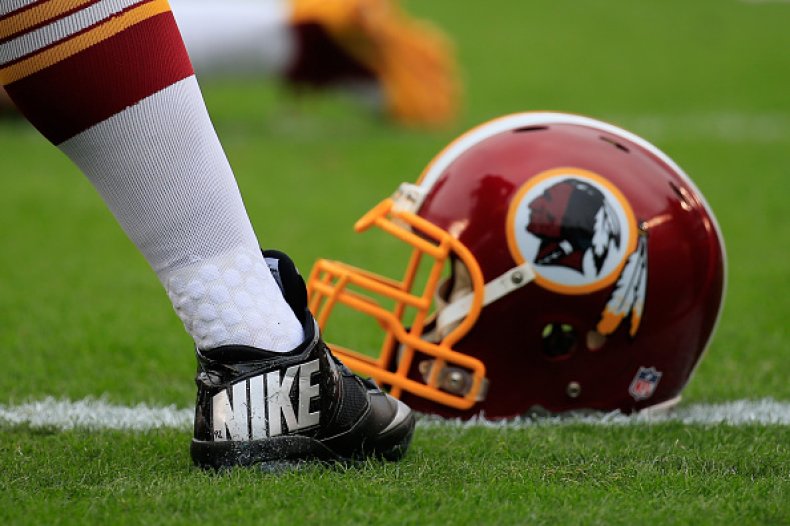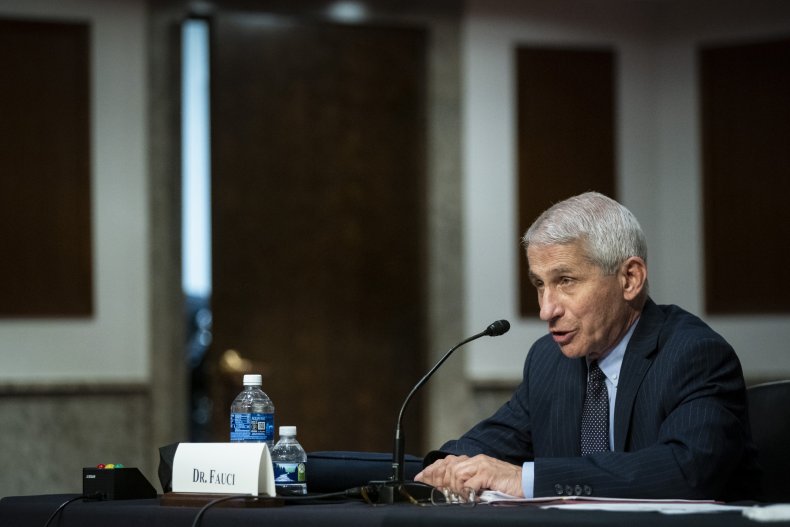Washington Redskins in internal talks to change the team name: report
July 3, 2020 By Matthew Chapman

On Friday, the Washington Redskins football team released a statement announcing that they are undertaking an internal review of the team name.
“This process allows the team to take into account not only the proud tradition and history of the franchise but also input from our alumni, the organization, sponsors, the National Football League and the local community it is proud to represent on and off the field,” said team owner Dan Snyder
Potentially big news: The #Redskins have been having internal discussions about their team name and now will conduct a formal, thorough review. Full statement, including quotes from owner Dan Snyder, on a possible name change: pic.twitter.com/49mpesZGs9
— Ian Rapoport (@RapSheet) July 3, 2020
For years, Snyder has vehemently resisted any and all calls to change the team name, which is broadly considered to be an offensive slur of Native Americans and has a long history of derogatory use. Snyder has insisted that the team’s name is meant to honor Native heritage.
The announcement comes as a number of groups and organizations reconsider terminology and iconography with racially and culturally insensitive origins, from Aunt Jemima syrup to musical groups like Lady Antebellum and the Dixie Chicks.
Nike Pulls Redskins Online Merchandise, Hours After FedEx Demands a Name Change
BY SCOTT MCDONALD ON 7/2/2020
The Washington Redskins have avoided changing the team's nickname for more than 50 years of political pressure. Politicians and human rights advocacy groups could not find a way to make it happen. But in a span of a few hours on Thursday, two major corporate sponsors may have sacked the team's ability to keep moving forward with its name.
First, FedEx demanded the team change its name from Redskins. Why is that significant? FedEx holds the naming rights to the team's stadium, and the company could pull it sponsorship worth many millions of dollars if the team doesn't comply.
What Have the Redskins' Major Sponsors Said About NFL Team Name Change?
READ MORE
And on Thursday night, Nike no longer carries any Washington Redskins merchandise on its website—although all other 31 teams in the NFL are represented.
The move comes after the top three Redskins sponsors—Nike, FedEx and PepsiCo—each received a letter Wednesday signed by 87 different investors and shareholders whose total net worth is $620 billion. They all urged the companies to pull their sponsorships unless the Redskins change their nickname.
"This is a broader movement now that's happening that Indigenous peoples are part of," said Carla Fredericks, who is director of First Peoples Worldwide and director of the University of Colorado Law School's American Indian Law Clinic. "Indigenous peoples were sort of left out of the civil rights movement in the late 1960s in many respects, because our conditions were so dire on reservations and our ability to engage publicly was very limited because of that. With social media now, obviously everything is very different."
FedEx made its move on Thursday afternoon, insisting the team change its name. The Memphis-based company made it clear with just one sentence.
READ MORE
Washington Redskins Urged to Lose Name, or Millions in Sponsorships
AOC Slams Redskins, Says 'Change Your Name' if Team Wants 'Racial Justice'
Ron Rivera Dismisses Redskins Name Change as 'Discussion for Another Time'
Since then, and even before then, many colleges and universities have dropped or changed nicknames. Miami University in Ohio changed its named from Redskins to Redhawks.
Lawsuits have continuously been filed against the Washington Redskins, but the organization has never wavered. Snyder even said in 2013 that he would never change the team's name.
After the death of George Floyd on May 25 while in custody of police, protests against his death—and police brutality against Blacks, in general—swept the nation. There have also been protests for equality of all races, including Native Americans.
In the letter from the investors to Nike, it stated, "the use of the R-word as the name and mascot of the Washington National Football League team is offensive and hurtful to American Indian and Alaska Native people and causes direct, harmful effects on the physical and mental health and academic achievement of the American Indian and Alaska Native populations, particularly youth; and ... despite the team's arguments to the contrary, the R-word is not a term of honor or respect, but rather, a term that still connotes racism and genocide for Native peoples and for all others who know of this history and recognize that it is wrong to characterize people by the color of their skin."
Sponsor FedEx asks Redskins to change their name

In this Dec. 9, 2018, file photo, FedEx Field is less than full during the second half of an NFL football game between the Washington Redskins and the New York Giants in Landover, Md. The title sponsor of the Redskins’ stadium wants them to change their name. FedEx said in a statement Thursday, July 2, 2020, “We have communicated to the team in Washington our request that they change the team name.“ (AP Photo/Mark Tenally, File)
WASHINGTON (AP) — The title sponsor of the Washington Redskins’ stadium wants the NFL team to change its name.
“We have communicated to the team in Washington our request that they change the team name,“ FedEx said in a statement Thursday.
The company paid the team $205 million in 1999 for the naming rights to FedEx Field in Landover, Maryland.
In addition to the stadium name and sponsorship agreement, FedEx CEO Frederik Smith is a minority owner. Majority owner Daniel Snyder has shown no indications he’ll change the name since buying the team in 1999.
Amid the national debate over race, pressure has been mounting on the organization to abandon the name called a “dictionary-defined racial slur” by experts and advocates.
Investors this week wrote to FedEx, PepsiCo and other sponsors asking them to request a change. FedEx is believed to be the first to take action.
Asked about Snyder changing the name, a spokesman said recently the team had no comment. The team last week removed the name of racist founder George Preston Marshall from its Ring of Fame at FedEx Field, and a monument to him was removed from the site of the old RFK Stadium.
Washington, D.C., mayor Muriel Bowser also said the name was an “obstacle” to the team returning to the District. The team’s lease at FedEx Field expires in 2027, and it is still talking to Washington, Virginia and Maryland about building a new stadium.
___
More AP NFL: https://apnews.com/NFL and https://twitter.com/AP_NFL
July 3, 2020 By Matthew Chapman

On Friday, the Washington Redskins football team released a statement announcing that they are undertaking an internal review of the team name.
“This process allows the team to take into account not only the proud tradition and history of the franchise but also input from our alumni, the organization, sponsors, the National Football League and the local community it is proud to represent on and off the field,” said team owner Dan Snyder
Potentially big news: The #Redskins have been having internal discussions about their team name and now will conduct a formal, thorough review. Full statement, including quotes from owner Dan Snyder, on a possible name change: pic.twitter.com/49mpesZGs9
— Ian Rapoport (@RapSheet) July 3, 2020
For years, Snyder has vehemently resisted any and all calls to change the team name, which is broadly considered to be an offensive slur of Native Americans and has a long history of derogatory use. Snyder has insisted that the team’s name is meant to honor Native heritage.
The announcement comes as a number of groups and organizations reconsider terminology and iconography with racially and culturally insensitive origins, from Aunt Jemima syrup to musical groups like Lady Antebellum and the Dixie Chicks.
Nike Pulls Redskins Online Merchandise, Hours After FedEx Demands a Name Change
BY SCOTT MCDONALD ON 7/2/2020
The Washington Redskins have avoided changing the team's nickname for more than 50 years of political pressure. Politicians and human rights advocacy groups could not find a way to make it happen. But in a span of a few hours on Thursday, two major corporate sponsors may have sacked the team's ability to keep moving forward with its name.
First, FedEx demanded the team change its name from Redskins. Why is that significant? FedEx holds the naming rights to the team's stadium, and the company could pull it sponsorship worth many millions of dollars if the team doesn't comply.
What Have the Redskins' Major Sponsors Said About NFL Team Name Change?
READ MORE
And on Thursday night, Nike no longer carries any Washington Redskins merchandise on its website—although all other 31 teams in the NFL are represented.
The move comes after the top three Redskins sponsors—Nike, FedEx and PepsiCo—each received a letter Wednesday signed by 87 different investors and shareholders whose total net worth is $620 billion. They all urged the companies to pull their sponsorships unless the Redskins change their nickname.
"This is a broader movement now that's happening that Indigenous peoples are part of," said Carla Fredericks, who is director of First Peoples Worldwide and director of the University of Colorado Law School's American Indian Law Clinic. "Indigenous peoples were sort of left out of the civil rights movement in the late 1960s in many respects, because our conditions were so dire on reservations and our ability to engage publicly was very limited because of that. With social media now, obviously everything is very different."
FedEx made its move on Thursday afternoon, insisting the team change its name. The Memphis-based company made it clear with just one sentence.
"We have communicated to the team in Washington our request that they change the team name," FedEx said in a statement .
Then, in a particularly-quiet move, Nike removed all Washington Redskins merchandise from its website. The Redskins are not listed among the other NFL teams, nor are they listed after a search on the site.

Then, in a particularly-quiet move, Nike removed all Washington Redskins merchandise from its website. The Redskins are not listed among the other NFL teams, nor are they listed after a search on the site.

A Washington Redskins Nike cleat and helmet is seen on the field before the game against the Philadelphia Eagles at Lincoln Financial Field on September 21, 2014 in Philadelphia, Pennsylvania.PHOTO BY ROB CARR/GETTY IMAGES
Native American groups in the late 1960s began efforts to end any harmful stereotypes or images of Native American life, especially in the sports world. By the early 1970s, there became a growing plea from activists for the Redskins to drop their name, or change its mascot altogether.
Although requests for sports teams to change their mascots from Indians and similar names somewhat dissipated throughout the 1980s, it began picking up steam again following the 1991 season, when the Redskins advanced to the Super Bowl XXVI in Minneapolis.
About 3,000 demonstrators showed up at the game to protest the Redskins name—the largest such protest at the time. Later that year, a Native American group filed a petition to have the team's nickname removed from trademark.
A federal appeals board sided with the petitioners, but the Redskins appealed the ruling. The board ruled that the team's name was belittling to Native Americans.
In 2004, a poll of 768 self-identified Indians showed that only nine percent of them were offended by Washington's nickname, and it's a survey that owner Daniel Snyder has used to this day as a way to defend the Redskins organization and brand.
Native American groups in the late 1960s began efforts to end any harmful stereotypes or images of Native American life, especially in the sports world. By the early 1970s, there became a growing plea from activists for the Redskins to drop their name, or change its mascot altogether.
Although requests for sports teams to change their mascots from Indians and similar names somewhat dissipated throughout the 1980s, it began picking up steam again following the 1991 season, when the Redskins advanced to the Super Bowl XXVI in Minneapolis.
About 3,000 demonstrators showed up at the game to protest the Redskins name—the largest such protest at the time. Later that year, a Native American group filed a petition to have the team's nickname removed from trademark.
A federal appeals board sided with the petitioners, but the Redskins appealed the ruling. The board ruled that the team's name was belittling to Native Americans.
In 2004, a poll of 768 self-identified Indians showed that only nine percent of them were offended by Washington's nickname, and it's a survey that owner Daniel Snyder has used to this day as a way to defend the Redskins organization and brand.
READ MORE
Washington Redskins Urged to Lose Name, or Millions in Sponsorships
AOC Slams Redskins, Says 'Change Your Name' if Team Wants 'Racial Justice'
Ron Rivera Dismisses Redskins Name Change as 'Discussion for Another Time'
Since then, and even before then, many colleges and universities have dropped or changed nicknames. Miami University in Ohio changed its named from Redskins to Redhawks.
Lawsuits have continuously been filed against the Washington Redskins, but the organization has never wavered. Snyder even said in 2013 that he would never change the team's name.
After the death of George Floyd on May 25 while in custody of police, protests against his death—and police brutality against Blacks, in general—swept the nation. There have also been protests for equality of all races, including Native Americans.
In the letter from the investors to Nike, it stated, "the use of the R-word as the name and mascot of the Washington National Football League team is offensive and hurtful to American Indian and Alaska Native people and causes direct, harmful effects on the physical and mental health and academic achievement of the American Indian and Alaska Native populations, particularly youth; and ... despite the team's arguments to the contrary, the R-word is not a term of honor or respect, but rather, a term that still connotes racism and genocide for Native peoples and for all others who know of this history and recognize that it is wrong to characterize people by the color of their skin."

In this Dec. 9, 2018, file photo, FedEx Field is less than full during the second half of an NFL football game between the Washington Redskins and the New York Giants in Landover, Md. The title sponsor of the Redskins’ stadium wants them to change their name. FedEx said in a statement Thursday, July 2, 2020, “We have communicated to the team in Washington our request that they change the team name.“ (AP Photo/Mark Tenally, File)
WASHINGTON (AP) — The title sponsor of the Washington Redskins’ stadium wants the NFL team to change its name.
“We have communicated to the team in Washington our request that they change the team name,“ FedEx said in a statement Thursday.
The company paid the team $205 million in 1999 for the naming rights to FedEx Field in Landover, Maryland.
In addition to the stadium name and sponsorship agreement, FedEx CEO Frederik Smith is a minority owner. Majority owner Daniel Snyder has shown no indications he’ll change the name since buying the team in 1999.
Amid the national debate over race, pressure has been mounting on the organization to abandon the name called a “dictionary-defined racial slur” by experts and advocates.
Investors this week wrote to FedEx, PepsiCo and other sponsors asking them to request a change. FedEx is believed to be the first to take action.
Asked about Snyder changing the name, a spokesman said recently the team had no comment. The team last week removed the name of racist founder George Preston Marshall from its Ring of Fame at FedEx Field, and a monument to him was removed from the site of the old RFK Stadium.
Washington, D.C., mayor Muriel Bowser also said the name was an “obstacle” to the team returning to the District. The team’s lease at FedEx Field expires in 2027, and it is still talking to Washington, Virginia and Maryland about building a new stadium.
___
More AP NFL: https://apnews.com/NFL and https://twitter.com/AP_NFL

/cdn.vox-cdn.com/uploads/chorus_image/image/67009672/GettyImages_1223815652_h.0.jpg)
:no_upscale()/cdn.vox-cdn.com/uploads/chorus_asset/file/20064216/GettyImages_1219619589t.jpg)
:no_upscale()/cdn.vox-cdn.com/uploads/chorus_asset/file/20064208/GettyImages_1219989083t.jpg)
:no_upscale()/cdn.vox-cdn.com/uploads/chorus_asset/file/20064257/GettyImages_1218390729t.jpg)
:no_upscale()/cdn.vox-cdn.com/uploads/chorus_asset/file/20064240/GettyImages_1223464195t.jpg)
:no_upscale()/cdn.vox-cdn.com/uploads/chorus_asset/file/20064230/GettyImages_1223813512t.jpg)














/cdn.vox-cdn.com/uploads/chorus_image/image/67011182/1223425211.jpg.0.jpg)



